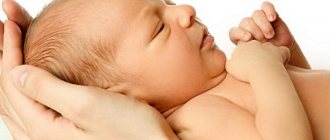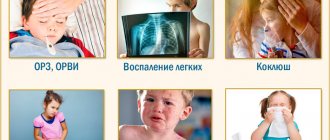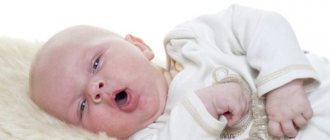Causes of allergic cough in children
Cough, as a rule, is caused by non-microbial antigens entering the body with inhaled air, or by pathogenic organisms already contained in the body. The determining factor for the development of an allergic reaction is the state of the child’s immune system.
The causes of allergic cough in a child are:
- inhalation of allergens – allergens may include particles of dust, animal hair, feathers, pollen or aerosol substances. This is how hay fever, bronchial asthma, pharyngitis and others appear;
- fungal infections of the respiratory system – the entry of yeast and mold fungi or their spores into the respiratory tract causes infectious inflammation. This process is facilitated by poor quality living conditions - the presence of mold, dampness, cold, as well as the imperfection of the children's immune system;
- parasites – when infected with helminths or protozoal infections, a cough appears against the background of general allergization of the body;
- The course of cough attacks is influenced by factors such as heredity, chronic bacterial inflammation, passive or independent smoking, and imperfect functioning of the children's immune system.
Pathogenesis of cough syndrome
In the development of cough syndrome in children against the background of allergies, the following blood components play a significant role - basophils, eosinophils, mast cells. This type of reaction of the body to an allergen is called immediate hypersensitivity. The course of the disease can be divided into several stages:
- the immunological phase is characterized by the accumulation of antibodies in mast cells;
- pathochemical is characterized by the release of histamine and other elements from mast cells and the re-entry of the allergen into the blood;
- pathophysiological is characterized by a reflex response of the body in the form of a cough to an irritant and actively occurring inflammation.
Symptoms of allergic cough in a child
An allergic cough in a child often has the following characteristics:
- unproductiveness;
- paroxysmal;
- dryness and barking character;
- coarseness;
- lasting more than several weeks or even months;
- no signs of infection such as fever or chills.
A cough may be combined with other manifestations of allergies - runny nose, sneezing, watery eyes, itching, redness and swelling of the eyes. Prolonged cough syndrome also causes pain in the chest area associated with overstrain of the skeletal muscles. Depending on the underlying disease, the nature and symptoms of an allergic cough in a child differ from each other.
Bronchial asthma worries at night or when the child wakes up. In this case, the cough is susceptible to bronchospasms and causes difficulty in exhaling. It can be triggered by various factors - laughter, crying, physical activity, nervous shock. During an attack, the child tries to take in as much air as possible with his mouth.
Allergic laryngitis is characterized by a superficial barking cough. In addition to it, hoarseness and sore throat appear. With the rapid development of the disease, shortness of breath, painful swallowing, blue discoloration of the nasolabial triangle and lips, weakness due to hypoxia in the tissues, and a feeling of a lump in the throat appear.
Chronic allergic alveolitis is characterized by the presence of sputum, and the cough itself appears at any time of the day. With this disease, the cough syndrome itself is often accompanied by headache, increased blood pressure and rapid pulse.
Obstructive bronchitis is characteristic of parasitic causes of allergic cough. In this case, the characteristic signs are wheezing, periodic shortness of breath, non-productive cough and additional manifestations - rash, redness, itching of the skin. It is even possible that eosinophilic pneumonia may occur.
Complications
Allergic diseases of the hypersensitive immediate type, accompanied by the presence of cough syndrome in children, without properly selected treatment or in an advanced form can cause complications:
- transition to a form of chronic disease that causes pneumosclerosis of the respiratory tract;
- formation of cor pulmonale due to blood stagnation;
- respiratory failure;
- stenosing laryngitis;
- asthmatic status.
If the last three types of complications occur, the child should be immediately hospitalized. JSC "Medicine" (academician Roitberg's clinic) offers conditions for hospitalization in a children's hospital located in the center of Moscow.
Diagnostics
Correct diagnosis and treatment of the symptoms of allergic cough in a child allows you to prescribe adequate therapy.
A complete examination consists of the following stages:
- initial appointment - examination of the child’s general condition, auscultation and palpation of the respiratory tract, this is necessary to collect primary medical history information. A survey is also carried out and the seasonal nature of the cough, the time of its more frequent manifestation, and other complaints are established;
- laboratory tests - the results of a general blood test should show an increased content of neutrophils, eosinophils and an increased erythrocyte sedimentation rate. A stool test is taken if a parasitic nature of the allergy is suspected; in case of asthmatic manifestations, a sputum test is performed and eosinophils are detected in it;
- instrumental diagnostic methods - spirometry, plain radiography, computed tomography;
- Allergy tests are skin tests that can be prescribed to children after reaching the age of two years.
Which specialist should you contact?
How to treat an allergic cough in a child is a question that torments thousands of parents. Only a specialist can choose the right therapy. If you have an allergic cough in children, you can contact the following doctors: pediatrician, pediatric allergist, pediatric immunologist, pediatric pulmonologist. You can make an appointment with the appropriate doctor at JSC “Medicine” (clinic of Academician Roitberg) using the website https://www.medicinadeti.ru/nashi-vrachi/, by phone or by personally visiting the clinic in the center of Moscow.
Allergic cough in children: self-diagnosis
With allergic pharyngitis, the cough is dry and obsessive. Attacks are provoked by contact with an allergen, as well as changes in temperature or air humidity. The cough is accompanied by a feeling of “lump” in the throat. Pain when swallowing and fever are not typical.
Allergic laryngitis most often develops in children aged 1 to 3 years. The attacks of dry cough are accompanied by hoarseness of voice. In acute cases, laryngitis can provoke a life-threatening condition - laryngeal edema.
Allergic tracheitis is manifested by a rough, dry cough, often at night. The cough is accompanied by pain behind the sternum, along the trachea.
Allergic lesions of the lower respiratory tract (obstructive bronchitis, bronchial asthma, alveolitis) are characterized by more severe symptoms: the presence of wheezing in the lungs, which is sometimes heard at a distance, a feeling of heaviness in the chest, difficulty breathing, shortness of breath, suffocation.
Treatment of allergic cough in children
Allergic cough is treated in the same way as any other allergic disease, taking into account some features of the course of the disease. Initially, it is necessary to eliminate the child’s contact with the allergen. There are several options for treating allergic cough in a child:
- antiallergic therapy consists of taking antihistamines to eliminate inflammatory reactions. Here it is most rational to choose more modern drugs of the second and third generation;
- inhalation therapy is used for bronchial asthma to relieve coughing attacks. The effect is aimed at increasing the clearance in the respiratory tract by reducing tissue swelling, eliminating inflammation and mucus. The dosage of drugs is prescribed by the doctor depending on the frequency of attacks and the age of the child;
- expectorants are aimed at relieving allergy symptoms by reducing the duration and frequency of coughing attacks;
- Allergen-specific immunotherapy (ASIT) is essentially a specific immunotherapy based on the introduction of small doses of allergens into the child’s body to provoke the immune system. Such therapy is not prescribed until the child reaches the age of 5 years;
- If the allergy is parasitic in nature, adequate treatment can be prescribed only after consultation with an infectious disease doctor. Therapy consists of taking antiparasitic drugs, preference is given to universal drugs with a wide range of effects on parasites.
Parents should be wary of folk remedies for treating an allergic cough in a child, but some methods are still quite effective:
- rinsing the nasopharynx with warm water with the addition of sea salt several times a day (especially after the child returns from the street) will reduce the number of microparticles of antigens entering the body through the upper respiratory tract and retaining on the mucous membranes of the nose;
- Relieving cough symptoms will be achieved by taking a decoction based on honey and bay leaf. You can take a quarter glass a day only if you are not allergic to honey;
- during coughing attacks, you can give your child a tablespoon of syrup made from two or three cloves of garlic with sugar or honey. Also, this remedy should not be taken if the child is allergic to honey.
You can learn more about treatment methods at JSC “Medicine” (academician Roitberg’s clinic) by scheduling an initial consultation by phone.
Barking cough
Diphtheria
10570 08 June
IMPORTANT!
The information in this section cannot be used for self-diagnosis and self-treatment.
In case of pain or other exacerbation of the disease, diagnostic tests should be prescribed only by the attending physician. To make a diagnosis and properly prescribe treatment, you should contact your doctor. Barking cough: causes of occurrence, what diseases it occurs with, diagnosis and treatment methods.
Definition
Cough is a physiological protective reaction of the body in response to irritating substances entering the respiratory system (less often, the digestive tract). The respiratory epithelium, which covers the respiratory tract from the inside, protects the body from the penetration of infectious agents (bacteria, viruses, etc.), retains dust particles inhaled with the air on its surface, and also helps cleanse the respiratory tract from them. The cells of the epithelium of the respiratory tract are adjacent quite tightly to each other, forming a barrier that does not allow microbes to pass through. A secretion (mucus) is produced on the surface of the epithelium, which moisturizes the epithelium and air passing through the respiratory tract, and also creates an additional barrier to infection. The respiratory epithelium has special cilia on its surface that help cleanse the walls of the respiratory tract, “washing out” mucus with dust and microorganisms settled on it in the direction from bottom to top.
The mucous membrane of the respiratory tract is well supplied with blood, which ensures warming of air coming from outside, sufficient mucus production and timely transportation of leukocytes (immune cells) to the area where infectious agents enter.
With the development of inflammatory changes in the wall of the respiratory tract or when they are irritated, for example by dust or caustic gases, the cough center is activated.
Types of cough
Depending on the presence of sputum, dry and wet cough are distinguished. Interestingly, these two types of cough can replace each other during the course of the disease.
Based on timbre, coughs are classified into silent, muffled, hoarse and others, among which the barking cough occupies a special place.
When describing this type of cough, it is appropriate to say that it really is somewhat reminiscent of a dog barking: just as loud and sharp, often with a metallic tint.
Possible reasons for the development of a barking cough
A barking cough usually indicates damage to the larynx.
The larynx with the vocal folds located in it plays a key role in the vocal apparatus. The vocal folds are stretched between cartilaginous structures, the degree of their tension is regulated by the laryngeal apparatus. Between the two vocal folds there is a gap through which the air exhaled from the lungs passes, creating oscillatory movements. The length of the vocal folds and the frequency of vibration determine the characteristics of the voice and cough in people with lesions of the vocal apparatus.
Inflammatory diseases of the larynx are grouped under the general name “laryngitis”. Inflammation of the larynx often develops in connection with an infectious lesion of the upper respiratory tract, and isolated inflammation of the larynx occurs quite rarely; much more often, the infectious process spreads to the larynx from the pharynx or trachea. Other causes of laryngitis are thermal injuries (exposure to gaseous substances that have a high temperature), inhalation injury from gaseous caustic chemicals, and allergic processes. Laryngitis develops when the vocal apparatus is overstrained.
Diseases that cause barking cough
Among infectious lesions of the larynx leading to the development of a barking cough, it is customary to distinguish two groups of diseases:
- Diphtheria of the larynx is an infectious disease of a bacterial nature, characterized by the formation of lamellar plaques in the respiratory tract, which are prone to independent separation from the mucous membrane and lead to blockage of the lumen of the respiratory tract, up to a complete disruption of their patency.
This condition is called “true croup” - it is characterized by gradual, steady progression, hoarseness with a further decrease in the volume of the cough. - Acute stenosing laryngotracheitis is an infectious inflammation of the trachea and larynx, leading to obstruction of the airways due to severe swelling of the laryngeal mucosa. This disease is also called false croup, because it is not caused by diphtheria bacillus, but by viruses (parainfluenza, influenza, respiratory syncytial virus) and bacteria - for example, mycoplasma.
False croup usually begins on the 1st–3rd day of a cold, acutely, suddenly, often at night.
A barking cough and severe difficulty breathing are the main signs of this condition.
It is worth saying that true croup affects people who were not vaccinated against diphtheria in childhood.
False croup is a condition characteristic of childhood (usually up to 5 years) - this is due to the structural features of the larynx in children (narrow, with soft cartilage, having a good blood supply to the mucous and submucous membranes), as a result of this structure there is a rapid increase in inflammatory edema and development severe airway obstruction. Which doctors should I contact if I develop a barking cough?
Emergency care for a patient with a barking cough and respiratory distress is usually provided by an emergency physician. Further management of such a patient depends on the cause of the development of barking cough. So, if diphtheria is suspected, the patient is hospitalized in an infectious diseases hospital, where an infectious disease specialist will treat him. If false croup develops in a child, therapy is carried out.
Diagnosis and examinations for barking cough
Diagnosis of a barking cough begins with interviewing the patient (or his parents, if the patient is a child) and finding out the circumstances under which the cough developed. Then the doctor conducts a clinical examination, an integral part of which is examining the oral cavity and listening to breathing sounds using a phonendoscope. Based on the data obtained, a presumptive diagnosis is formed, which requires clarification after the acute condition has been relieved and the risk of developing acute respiratory disorders in the patient has been eliminated.
To diagnose diphtheria, material from the throat and respiratory tract is cultured for the presence of the causative agent of the disease - Corynebacterium diphtheria
.
Prognosis and prevention
If parents can follow the recommendations of children's allergists and eliminate the child's contact with the allergen, then the prognosis for the treatment of allergic cough in children is favorable with a minimal risk of developing negative complications. Prevention of allergic cough comes down to creating an allergen-free environment around the child. Also, timely access to a doctor for treatment and favorable living conditions play an important role.
Creating a hypoallergenic environment consists of a few simple recommendations:
- eliminating sources of household dust - books on open shelves, carpets on the floor and walls;
- minimizing textile and plush toys for a child;
- purchasing plastic and rubber products without a specific pungent odor.
In the children's room, it is necessary to regularly carry out wet cleaning, using hypoallergenic cosmetics and safe household chemicals. It is better to minimize direct contact with animals as a source of wool.
During pregnancy, mothers are advised to exclude allergenic foods from their diet and spend more time outdoors. It is necessary to regularly carefully examine the child’s skin and immediately consult a doctor at the first manifestations of diathesis. This problem cannot be considered harmless; it will not go away on its own. Remember that any manifestations of allergies require an immediate response from both parents and doctors. Inaction contributes to the occurrence of complications, for example, bronchial asthma. How quickly your child will receive help in resisting allergic diseases depends only on the vigilance of parents.
Symptoms of cough in case of allergies
Is it possible to determine that this is an allergic cough in children, but not any other?
Allergy symptoms:
- The cough appears suddenly, it is usually paroxysmal, suffocating (sometimes parents notice that before the attack there was contact with a potential irritant: for example, the child was stroking a cat, smelling a flower).
- The attacks are long and repeated at certain intervals.
- The cough is painful, dry, and can last up to three weeks; there is no fever, no itching in the nasopharynx or sneezing.
- For the most part, attacks occur at night; during the day they occur much less often.
- As a rule, doctors note the dryness of an allergic child’s cough. However, sometimes clear sputum is released, in which there are no impurities.
- Sometimes rhinitis (allergic in nature) is present.
- It is enough to take an antihistamine and the cough will disappear.
Symptoms of allergic reactions depend on the type of allergy. A timely visit to an allergist during coughing attacks will help eliminate the risk of allergic bronchitis or asthma.
Childhood allergy cough and whooping cough: difference in manifestations
Whooping cough is also accompanied by attacks of dry cough. The disease is very serious. For babies, it can lead to respiratory arrest.
The basic differences between whooping cough and allergic attacks are as follows:
- Whooping cough causes an increase in temperature, but with allergies the temperature is normal.
- Allergy attacks occur as a result of encountering an irritant.
- With an allergy accompanied by a cough, there is no whistling noisy inhalation, which is a sign of whooping cough.
- Attacks of whooping cough cannot be controlled with an antihistamine.
- Sputum from whooping cough is often viscous and difficult to remove.
If there is any paroxysmal cough, you should immediately show the child to a specialist.
What causes a cough?
Doctors list the main reasons that can cause allergic cough in children:
- The saliva and particles of cat skin (or rather, the protein-protein) found in them can sometimes cause other animals to cause an allergic reaction. There is always saliva and dead skin in the smallest form on the fur of pets.
- Ticks. There are many of them in pillows, carpets, etc.
- Dust (it contains mite particles).
- Plant pollen.
- Bird feathers.
- Chemical household products, cosmetic aerosols.
- Mold, fungal spores.
Sometimes an allergic cough develops after diseases of the respiratory tract: the virus or bacteria is no longer in the body, but the immune reactions triggered by the microbe still last.
How is it treated
Inevitably, parents are faced with the problem of how to treat an allergic cough in a child. Such manifestations of allergies will disappear if the child is removed from contact with the irritant or from reacting to it.
Why the attacks occur and what the child reacts to, parents will not figure it out on their own. The risk of developing allergic manifestations increases if one of the parents is allergic.
Therapy is prescribed and carried out exclusively by an allergist. But some easy preventive measures can be taken at home.
These are general rules: ventilate the apartment often, do daily cleaning (wet). You can teach children to rinse their mouth and throat with warm water, especially after going out.











